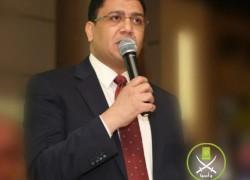- Election Coverage
- November 9, 2005
- 4 minutes read
In Egypt’s elections, symbols are more than symbolic
In Egypt’s elections, symbols are more than symbolic
VOTE GRABBERS: With the illiteracy rate at around 50 percent, many people select their candidates from the logos on the ballot — which range from umbrellas to tanks
AFP , CAIRO
Opposition leader and former presidential challenger Ayman Nour, right, who is running for re-election to parliament, holds his hand over his heart as he acknowledges supporters at a rally in Cairo on Monday. The elections open today and will end on Dec. 7.
PHOTO: EPA
Dove or tank? Tennis racket or mobile phone? In Egypt, where close to half of the population is believed to be illiterate, a good choice of campaign symbol can be decisive on polling day.
The ruling National Democratic Party (NDP) of President Hosni Mubarak makes no mistake and systematically reserves itself the Islamic crescent and the camel, which have proved their vote-grabbing potential over the years.
But the pecking order ends with the all-powerful NDP, leaving other candidates scrambling for the best remaining symbols.
In Cairo’s impoverished Bulaq Dakrur constituency, the camel and the crescent will face a stiff challenge from the umbrella and the open book, logos for the Muslim Brothers and the hardline Gamaa Islamiya respectively.
“It’s easier to remember the symbols than the names of the candidates,” said Rasha Mohammed Ali.
No fewer than 529 candidates will battle it out today in the 25 constituencies of the Egyptian capital, one of eight governorates to be decided in the first wave of polling.
A total of 5,310 candidates nationwide are competing for parliament’s 444 available seats during elections staggered over a whole month.
As he stares at the patchwork of posters plastered on the walls on Cairo’s Dokki neighborhood, Mohammed Badri Abdallah offers his own explanation for the use of campaign symbols.
“These little logos were introduced for women, who often can’t read,” he said. According to most estimates, illiteracy rates hover above 40 percent for Egyptian men and reach the 50 percent mark for women.
The forest of campaign banners and posters mingling with decorations for the holy Muslim month of Ramadan and clusters of electricity cables and phone lines above Cairo’s sandy alleyways can be overwhelming even to the literate.
Thus a distinctive symbol, whether representative or not of the party’s platform or the candidate’s profile, can be a serious asset.
On election day, some voters will tick off the symbol they can identify or simply their favorite logo rather than a name they can’t read.
The determining factor in selecting a symbol often remains mysterious.
A female lawyer running in the central district of Dokki chose a cup, while others opted for the walking stick, the Ramadan lantern, the pencil or the rababa, a traditional Egyptian string instrument.
Nature-related symbols are considered safe choices, with doves, palm trees, grapes and suns among the most sought-after campaign logos.
Some would-be members of parliament wishing to convey a more modern image chose the light bulb, the aircraft and the mobile phone, while candidates in a more bellicose mood decided to run under the symbol of the tank, the sword or the handgun.
Independent candidate Adel Abdu is a contender for the prize of the healthiest symbol with a tennis racket, although courts are few and far between his destitute industrial neighborhood of Shubra al-Khima.
The Muslim Brotherhood, Egypt’s largest opposition force which has promised to mount a tough challenge to the ruling party in the elections, has no symbol strategy and leaves each candidate to make his pick.



